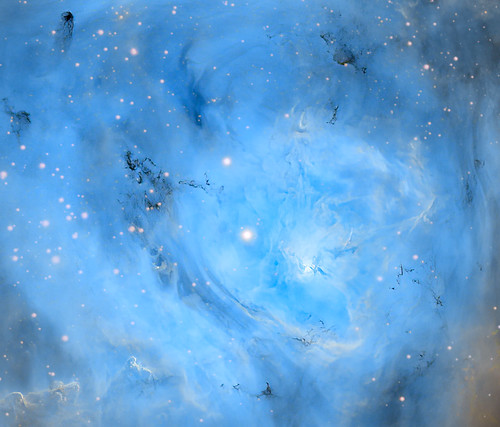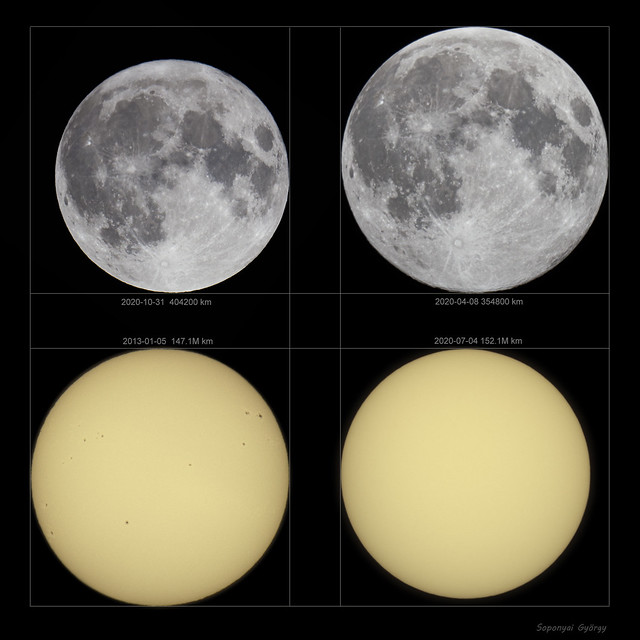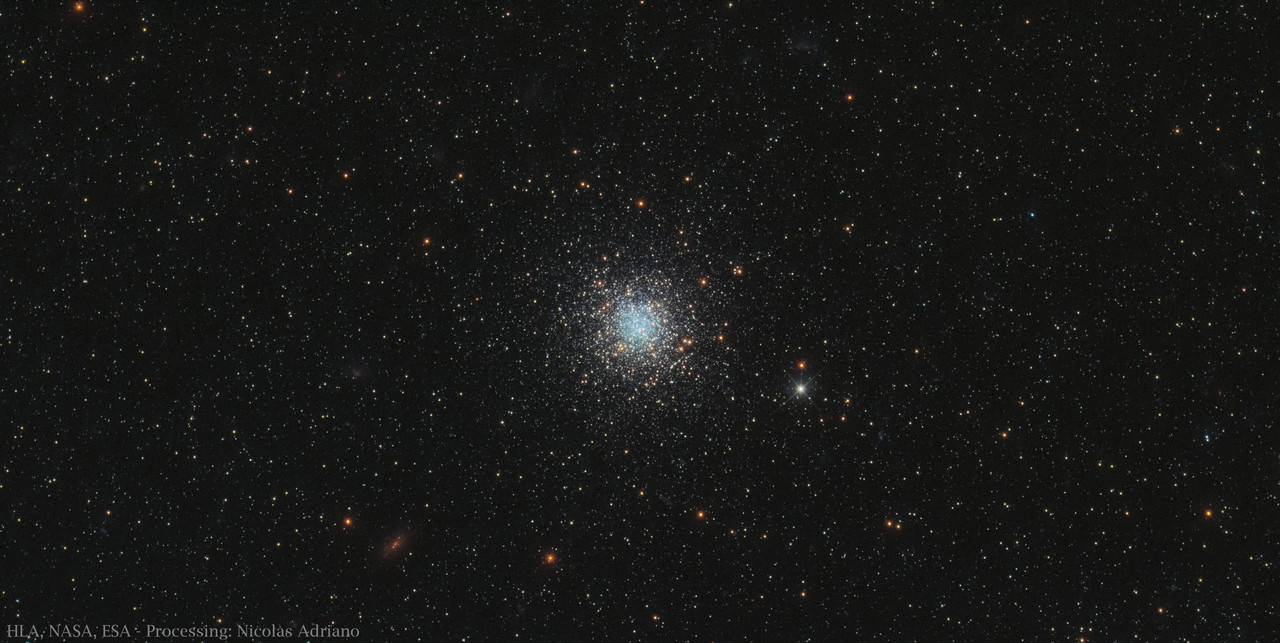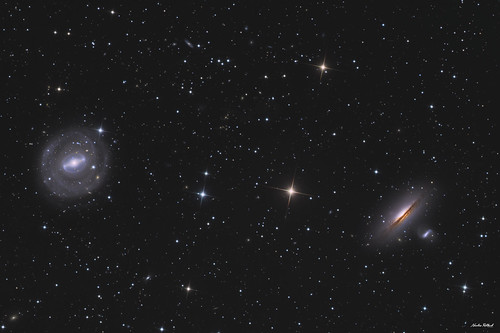Submissions: 2020 November
-
thomasroell
- Ensign
- Posts: 28
- Joined: Tue Oct 27, 2020 7:23 pm
Re: Submissions: 2020 November
I would like to submit the following image for review for APOD.
The target in this image is the Cygnus Wall, the brightest part in the North America Nebula, NGC7000.
The data was shot on the night of September 19th, form my home in the Northern part of The Netherlands, Bortle class 5 skies.
Optics: TS-Optics 115mm Triplet APO
Camera: Astro modified Canon 750D
Subs: 43 x 600 seconds ISO 3200
Thank you for your time,
Kind regards,
Thomas Röell
Instagram: @pilot_astro
The target in this image is the Cygnus Wall, the brightest part in the North America Nebula, NGC7000.
The data was shot on the night of September 19th, form my home in the Northern part of The Netherlands, Bortle class 5 skies.
Optics: TS-Optics 115mm Triplet APO
Camera: Astro modified Canon 750D
Subs: 43 x 600 seconds ISO 3200
Thank you for your time,
Kind regards,
Thomas Röell
Instagram: @pilot_astro
-
Jean-Baptiste Auroux
- Ensign
- Posts: 78
- Joined: Tue Nov 14, 2017 10:06 pm
Re: Submissions: 2020 November
Soul on fire (IC 1848 )
Full version : https://astrob.in/full/ajols4/C/?real=
IC 1848 - Soul nebula in Cassiopeia. HOO version.
Takahashi TSA102 - AZEQ6 - Atik Cameras Atik16200
Ha : 50 x 900s (bin1)
OIII : 36 x 600s (bin2)
Total integration : 18h30
22, 23, 24 & 25 August 2019 - Fouras (France)
Pixinsight - Photoshop
Copyright: Jean-Baptiste Auroux
https://millenniumphoton.com/
https://www.astrobin.com/users/Jean-Baptiste_Paris/
Full version : https://astrob.in/full/ajols4/C/?real=
IC 1848 - Soul nebula in Cassiopeia. HOO version.
Takahashi TSA102 - AZEQ6 - Atik Cameras Atik16200
Ha : 50 x 900s (bin1)
OIII : 36 x 600s (bin2)
Total integration : 18h30
22, 23, 24 & 25 August 2019 - Fouras (France)
Pixinsight - Photoshop
Copyright: Jean-Baptiste Auroux
https://millenniumphoton.com/
https://www.astrobin.com/users/Jean-Baptiste_Paris/
-
Jean-Baptiste Auroux
- Ensign
- Posts: 78
- Joined: Tue Nov 14, 2017 10:06 pm
Re: Submissions: 2020 November
M51 Galaxy
Full version : https://astrob.in/full/99e9vs/M/?real=
Here is a portrait of M51 made in a collaborative team, cumulating nearly 100 hours of poses. This famous couple of interacting galaxies in the Big Dipper is often quoted to illustrate what galactic cannibalism can be.
To make the most of the participants' setups, we inlayed the roughs with the finest samples in those with the largest fields, which allowed us to benefit from the details in the galaxy as well as a sufficient field to highlight the very tenuous surrounding NFI, which is rarely seen in images.
We have selected from all the raw : 65 hours of Luminance, 15h of Halpha, 5h30 per RGB color layer
Acquisitions :
- Jean Baptiste Auroux (TSA 102 + Atik one 6.0)
- Julien Favre (TSA 120 + G2-4000)
- Mathieu Guinot (Esprit 120 + QSI 683)
- Fred Lamagat (RC8 @f/5 + Atik 4000)
- Matthieu Tequi (C9 Edge @f/7 + asi1600)
Processing : Aurélien Chapron & Mathieu Guinot
Copyright: Team Astropotes
https://www.facebook.com/astropotos/
https://www.astrobin.com/users/AstroPotes/
Full version : https://astrob.in/full/99e9vs/M/?real=
Here is a portrait of M51 made in a collaborative team, cumulating nearly 100 hours of poses. This famous couple of interacting galaxies in the Big Dipper is often quoted to illustrate what galactic cannibalism can be.
To make the most of the participants' setups, we inlayed the roughs with the finest samples in those with the largest fields, which allowed us to benefit from the details in the galaxy as well as a sufficient field to highlight the very tenuous surrounding NFI, which is rarely seen in images.
We have selected from all the raw : 65 hours of Luminance, 15h of Halpha, 5h30 per RGB color layer
Acquisitions :
- Jean Baptiste Auroux (TSA 102 + Atik one 6.0)
- Julien Favre (TSA 120 + G2-4000)
- Mathieu Guinot (Esprit 120 + QSI 683)
- Fred Lamagat (RC8 @f/5 + Atik 4000)
- Matthieu Tequi (C9 Edge @f/7 + asi1600)
Processing : Aurélien Chapron & Mathieu Guinot
Copyright: Team Astropotes
https://www.facebook.com/astropotos/
https://www.astrobin.com/users/AstroPotes/
Re: Submissions: 2020 November
Thomas, you made the Pelican Nebula look like enormous plumes of smoke rising from the smoldering ionization front of this nebula! I love it.thomasroell wrote: ↑Mon Nov 02, 2020 8:13 am This image is the popular target the Pelican Nebula, IC 5070, but flipped 180 degrees to make the bright “wall’ more prominent. It very much resembles the nearby Cygnus Wall.
This was shot two weeks ago from my home in the northern part of The Netherlands.
Optics: TS-Optics 115mm Triplet APO
Camera: Astro modified Canon 750D, Optolong L-Enhance filter
Subs: 40 x 600 seconds ISO 3200
Regards Thomas
Pelican_Nebula_40_frames_600s_08drizzle-Stpps.jpg
Ann
Color Commentator
Re: Submissions: 2020 November
Wissam, you're killing me! I can't resist that shade of blue!!Wissam Ayoub wrote: ↑Mon Nov 02, 2020 8:40 am Hi,
Thank you so much for this opportunity,
I also submitted my image yesterday in the October 2020 submissions due to the time difference with the US as the November submissions page was not yet available
Sorry for any duplicated data.
My submission: The HEART of the Lagoon Nebula M8
Imaging telescope: Explore Scientific 127mm ED TRIPLET APO.
Imaging camera: ZWO ASI1600MM Pro-Cool.
Focal reducer: Explore Scientific 0.7 Reducer/Flattener.
Mounts: iOptron CEM60.
Software: Photoshop CC 2020 Photoshop · PixInsight 1.8.8 Ripley · DeepSky Stacker (DSS) Deepskystacker 3.3.6
Filters:
Astronomik SII 1.25" 12 nm
Astronomik Ha 1,25" 12 nm
Astronomik OIII 1.25" 12nm
Locations: UAE desert, Abu Dhabi, United Arab Emirates
Copyright: Wissam Ayoub
Thank you,
Ann
Color Commentator
Re: Submissions: 2020 November
Rafael, I love both your images, both this one and the one of the Cocoon Nebula. I love how the famous sights are just parts of a larger, highly detailed skyscape. Thank you!RafaRo wrote: ↑Mon Nov 02, 2020 3:11 pm A SEAHORSE IN THE OCEAN
www.SkyandPhoto.com
Copyright: Rafael Rodriguez Morales
https://www.cieloyfoto.es/2020/10/un-ca ... ceano.html
The dark nebula cataloged as Banard 150 has the shape of a seahorse, coincidences, In this photograph of great field and detail it is immersed in the great Ocean of the universe, in this case a part of the Milky Way that falls towards the left to the reduce the number of stars.
You can see the Fireworks Galaxy (NGC 6946) and below a globular star cluster (NGC6939).
Photograph captured in the northern mountains of Seville (Spain) on the night of October 17 to 18, with the following equipment and capture data:
SuperApochromatic Telescope TMB 130/780 CNC II.
Massimo Riccardi Reducer / Flattener x0.75 of 81 mm.
Focal 585mm at F4.5.
Takahashi EM200 Temma2 mount.
QHY 367C Cold CMOS Camera.
Guided with the main camera, OAG with QHY5 LII camera.
Sensor temperature of - 10ºC.
Exposures 20x 600 ". RGB
Pixinsight 1.8.8.
Ann
Color Commentator
Re: Submissions: 2020 November
Daniel, I don't usually get a huge kick out of pictures of the Moon, but I can't resist the "blue Moon" of yours!Andromeda 2013 wrote: ↑Mon Nov 02, 2020 5:49 pm 4 Panel Blue Moon
https://www.flickr.com/photos/92681330@N06/50555605347
Copyright: Daniel Pasternak ©
Ann
Color Commentator
Re: Submissions: 2020 November
Hi and welcome to Starship Asterisk*, Connor! I like both images of yours!Cmccraw wrote: ↑Tue Nov 03, 2020 12:30 amNGC 1499 California Nebula by Connor Mccraw, on Flickr
Ngc 1499 California Nebula imaged in Ha and Oiii bicolor. It was imaged with a monochrome astronomy camera from my backyard over the span of a week. The data collected was shot with a 135mm camera lens mounted to my mount.
I enjoy Bicolor images of certain nebula compared to SHO images because the image becomes more bold and vibrant in its final combination.
The image was edited in Pixinsight and finished with Photoshop for final touches.
This image was created with a budget setup of a camera typically used for planetary imaging and a Rokinon 135mm lens on a Ioptron CEM25EC mount. I have been imaging just over a year and feel like my skill set has come a long way and I am learning with every image I produce.
Ann
Color Commentator
Re: Submissions: 2020 November
HI and welcome to Starship Asterisk*, Ashkay! That's a fine set of Moon images!akshay87kumar wrote: ↑Wed Nov 04, 2020 3:39 pm Thanks for the opportunity to post one of my images.
Please see attached some of the images of the full moon taken on the night of the Blue Moon of October 2020 (31 Oct). This is a 150-image stacked photograph created using PIPP and AutoStakkert, with post processing performed in Photoshop. I have increased the saturation of the image to reveal the colors reflected from the lunar surface. The terrain of the moon like craters, maria are also visible.
Equipment: Nikon D5300, Nikon 200-500mm f/5.6
150 exposures at 1/80s, ISO100, 500mm
Also attaching a couple other pictures:
1. Stacked picture of the moon taken on an early evening when the sky had sufficient light.
2. Another full moon stacked image, taken earlier in the year from a different location.
Ann
Color Commentator
Re: Submissions: 2020 November
Very interesting, György. We can see that the Earth's distance to the Sun varies a lot less than the Moon's distance from the Earth. And no wonder that the lunar disk isn't always big enough to cover the disk of the Sun during solar eclipses!vanamonde81 wrote: ↑Wed Nov 04, 2020 8:40 am Lunar and Solar Extremities
Copyright: György Soponyai
This photo sequence presents the the biggest and smallest visible Lunar and Solar disks taken with the same telescope and camera.
Canon EOS 5D Mark II + SkyWatcher 254/1200 Dobson
Ann
Color Commentator
Re: Submissions: 2020 November
Wissam, I think that's a brilliant image of the Tarantula nebula with the NGC 2070 and Hodge 301 clusters!Wissam Ayoub wrote: ↑Thu Nov 05, 2020 8:55 pm Hi,
My submission: Inside the Tarantula NGC 2070 - HST data
12539 × 13060 pixels.
HST data.
Processed in HOO.
Copyright: Wissam Ayoub
Thank you,
Ann
Color Commentator
Re: Submissions: 2020 November
Matt, I really like it! It looks as if the Andromeda galaxy was a UFO that was about to crash into the "wall" of the Milky Way. And it is going to crash into us, too, only not in the near future! Oh, and I like all the details of your image, the nebulas and the clusters.mdieterich wrote: ↑Fri Nov 06, 2020 7:50 pm Cassiopeia and surrounding area
www.mattdieterich.com
Copyright: Matt Dieterich What happens when you point a camera and lens at the sky for effectively 45 minutes? One can easily record stunning detail in our galaxy and also see galaxies outside our own. Here you can see unreal detail in the Andromeda Galaxy, beautiful red emission nebulae, dark nebulae, and an open cluster! Quite the buffet of deep sky objects all in one field of view, and that's why I love astrophotography.
Ann
Color Commentator
Re: Submissions: 2020 November
Hi and welcome to Starship Asterisk*, Brian! That's a fine picture of the Orion Nebula!Astrobrian wrote: ↑Sat Nov 07, 2020 6:52 pm M42 - Orion in HaRGB\
11 months after my first attempt at astrophotography I am back imaging my first target, M42. This time I tried a blend of HaRGB images taken over 8 hours and two nights.
https://www.astrobin.com/full/d0xdd9/
www.astrobrian.com
Copyright: Brian Rehrey 90 x 60s R
70 x 60s G
70 x 60s B
47 x 300s Ha
Total 7.8 Hours
Ann
Color Commentator
Re: Submissions: 2020 November
I love how you framed your image, Andrei. The Soul Nebula looks like a baby animal that jumps over a cosmic heart! It reminds me of the nursery rhyme, Hey diddle diddle, the cow jumped over the moon!andreigusan wrote: ↑Sun Nov 08, 2020 8:09 am
Hi all,
I want to share my biggest project so far: Heart & Soul Nebulae!
2 panel image taken with RedCat51 paired with ASI1600 mono.
Over 34 hours of total integration time required to get this result.
I handpicked 514 frames from many others, each of them with 4 minutes exposure.
Integrated with PixInsight and post-processed with PixInsight, Photoshop and Lightroom.
Telescope: RedCat51 f/4.9
Camera ZWO ASI1600MM Pro mono
Filters: Astronomik 6nm
S2: 141x240" (9.4 hrs)
Ha: 173x240" (11.5hrs)
OIII: 200x240" (13.3hrs)
Total integration time: +34 hours
Hi-resolution and more details here: https://www.astrobin.com/b7sj8m/
I hope you like it and thanks for watching.
Stay safe,
Andrei.
Ann
Color Commentator
Re: Submissions: 2020 November
HI and welcome to Starship Asterisk*! That a fine picture of the Orion Nebula and the Horsehead region!YSTY wrote: ↑Mon Nov 09, 2020 9:11 am
http://yann-sainty.com/m42_ici434_v_apod.png
Hi here is my submission for this month.
Horsead and Oriob nebulas in wide field.
Only 4 hours of exposure with 80 x 180 '' and 20 x 10''
Shorts exposures are for getting Orion's heart good.
Evostar 72ED with cor / red 0.85
Filter IDAS LPS D2 2 ''
Canon 6D modified
Eq3.2 mount
Without guidance
Bortle 6
And the full is here:
https://www.astrobin.com/6jj1mp/B/
On more time I would like to prove that it's possible to mâle great pics with a little setup.
Thank you and have a good day.
Ann
Color Commentator
Re: Submissions: 2020 November
That's so interesting, Nicolas! The Fornax dwarf is such a faint, puny galaxy, but this Fornax dwarf globular cluster looks fine indeed!Nicolas Adriano wrote: ↑Mon Nov 09, 2020 9:08 pm ESO-356-SC-005, Globular Cluster in Fornax Dwarf Galaxy
https://www.flickr.com/photos/nickkadri ... ed-public/
Copyright: HLA, NASA/ESA - Processing: Nicolas Adriano
Ann
Color Commentator
Re: Submissions: 2020 November
I'm not usually a great fan of mapped color images, but I think this picture looks lovely! And it's an unusual target, too, which makes it even more appealing.Kinch wrote: ↑Mon Nov 09, 2020 11:23 pm NGC 1491
Located on the edge of a vast cloud of gas, about 10,700 light-years away in the constellation Perseus, NGC 1491 is also an H II region (a large, low-density cloud of partially ionized gas in which star formation has recently taken place). Its central star (BD +50 886), is a young blue star with an 11.22 magnitude whose stellar winds are blowing a bubble in the surrounding gas.
Final NGC 1491 (1096 x 1096).jpg
This version is 25 Hours of exposure time: 10 hours Ha + 9 hours SII + 6 hours OIII with FSQ 130ED scope.
https://www.kinchastro.com/ngc-1491.html
Ann
Color Commentator
Re: Submissions: 2020 November
As a single exposure shot, I find this very interesting and beautiful.ajpsleiman wrote: ↑Tue Nov 10, 2020 4:03 pm Here is my submission
Copyright: Anthony Sleiman
The Shark Valley Observation Tower is a classic example of Mission 66 architecture, which is sometimes called "modern parkitecture" and features large slabs of concrete, swirling ramps, flat roofs, and terraces supported by thin columns. Providing panoramic 360-degree views of the River of Grass, the Shark Valley Observation Tower is accessed from the midpoint of the 15-mile (24 km) Tram Road. In this photo, we can see one of the most famous landmarks of the Everglades and the Milky Way galaxy lining up with the highest point of the tower. This photo was taken on August 23, 2020 and is a single exposure shot at 16 mm, 20 seconds, iso 6400 F4
Thank you,Shark-Valley-tower-Anthony-Sleiman.jpg
Ann
Color Commentator
Re: Submissions: 2020 November
That's a beautiful picture of three fascinating galaxies!Llama wrote: ↑Tue Nov 10, 2020 7:15 pm NGC 5101, NGC 5078 and others
Copyrights
Data acquisition: Martin PUGH
Processing: Nicolas ROLLAND
Acquisition May 2020
Total acquisition time of 26.3 hours.
Optics: Planewave 17“ CDK @ F6.8
Mount: Paramount ME
CCD: SBIG STXL-11002 (AOX)
Pre Processing: CCDstack & Pixinsight
Post Processing: Photoshop CC
NGC 5101 and Friends by Nicolas Rolland, sur Flickr
Ann
Color Commentator
Re: Submissions: 2020 November
That's fascinating, Luc. Your two pictures look good together!lup974 wrote: ↑Thu Nov 12, 2020 1:47 pm With or without fog
https://www.lucperrot.fr/
Copyright: Luc Perrot
It is often easy to plan a photo and compose with a landscape and a piece of sky and Milky Way. On the other hand, the weather is always an unpredictable element reserving good or bad surprises.
For this series, I was determined to photograph this Milky Way descending above the Cirque de Mafate in Reunion. It was the bridge between two of the highest peaks on the island, the Grand Bénare and the Morne de Fourche.
And then the fog arrived giving me the opportunity to take the same photo but with two totally different atmospheres.
With or without fog?
Ann
Color Commentator
Re: Between Perseus and Cassiopeia
Raul, Domingo and Nicolas, that's a fine wide-field portrait of Cassiopeia!alcarreño wrote: ↑Thu Nov 12, 2020 5:42 pm Copyrights: Raul Villaverde, Domingo Pestana and Nicolas Romo
Cassiopea, Corazon y Alma_2020 by Raul Villaverde, en Flickr
Ann
Color Commentator
Re: Submissions: 2020 November
Jean-Baptiste, thank you for that fine portrait of one of may favorite galaxies, M94!Jean-Baptiste Auroux wrote: ↑Thu Nov 12, 2020 6:23 pm Galaxy M94
Full version : https://cdn.astrobin.com/thumbs/qXsGhtk ... czOqwr.jpg
Hello,
For this image of the M94 Galaxy, I tried for the first time the "trendy" software "Topaz sharpen" for this image ; as many users do so now for their astro images.
The process was only applied on the inner core of the galaxy, and with many precautions (mask, low % of blend with the original… ) and rigorous verification that no virtual detail is created during the process.
For this image, most of the detail come from classic deconvolution and HDR processing on Pixinsight ; Topaz was only useful to quickly give a "sharpen" aspect to the core of the galaxy.
I think that used in that way, and with such precautions, it can be an interesting tool.
Setup : Takahashi TSA102 / AZEQ6 / CCD ArikOne6 / LRGB-Ha / Guiding : DO-AtikGP
L : 60 x 600s (bin1) + 15 x 180s (bin1) for HDR composition.
R/G/B : 3 x 20 x 180s (bin2)
Ha : 12 x 600s (bin1)
Total : 15h45
Fouras (France) - 21-23-24-25 May 2020
Copyright: Jean-Baptiste Auroux
https://millenniumphoton.com/
https://www.astrobin.com/users/Jean-Baptiste_Paris/
Ann
Color Commentator
Re: Submissions: 2020 November
Martin, that's a fin portrait of an interesting dwarf galaxy!martin_a wrote: ↑Fri Nov 13, 2020 4:28 am IC 1613
IC 1613 is an irregular dwarf galaxy, 2.3 million light years from earth. There is little dust associated with it which enables many background galaxies to be seen through it. IC 1613 helped astronomers work out how to utilize variable stars to determine the expansion rate of the universe. IC 1613 most closely resembles the nearby, transition-type dwarf galaxy Pegasus.
There are many blue star clusters and there is a bright HII region in the upper left.
Images obtained in September/October/November 2020 at Sierra Remote Observatories near Fresno, California
Astrodon CRGB filters
Clear: 36 x 20 minutes = 12 hours binned 1x1
Red, green, blue =16 x 15 minutes each = 4hours binned 2x2
Total exposure time =24 hours
RCOS 20 inch, Paramount ME II, SBIG 11K with AOL
Acquired with The Sky X, Processed with PixInsight
www.pbase.com/martinasc1
Copyright: Martin Ascherl
https://pbase.com/martinasc1/image/1712 ... iginal.jpg
Ann
Color Commentator
Re: Submissions: 2020 November
Thanks for the comment Ann, it is appreciated. I am aware that you normally do not like Narrow Band images but for some us, we have little choice (most of the time) because of light pollution. Odd how we all see things differently.......this would be my least favourite of the images I have submitted.Ann wrote: ↑Wed Dec 02, 2020 6:48 amI'm not usually a great fan of mapped color images, but I think this picture looks lovely! And it's an unusual target, too, which makes it even more appealing.Kinch wrote: ↑Mon Nov 09, 2020 11:23 pm NGC 1491
Located on the edge of a vast cloud of gas, about 10,700 light-years away in the constellation Perseus, NGC 1491 is also an H II region (a large, low-density cloud of partially ionized gas in which star formation has recently taken place). Its central star (BD +50 886), is a young blue star with an 11.22 magnitude whose stellar winds are blowing a bubble in the surrounding gas.
Final NGC 1491 (1096 x 1096).jpg
This version is 25 Hours of exposure time: 10 hours Ha + 9 hours SII + 6 hours OIII with FSQ 130ED scope.
https://www.kinchastro.com/ngc-1491.html
Ann
Re: Submissions: 2020 November
felix_wegerer wrote: ↑Fri Nov 13, 2020 11:38 am Fox Fur and Cone Nebula imaged in LHaRGB.
Chilescope Data aquisition.
FoxFur_LHARGB.jpg
Glad to see this picture of the Cone Nebula and Christmas Tree region that underscores the power of the blue O-type ionizing star, S (or 15) Monocerotis!
Ann
Color Commentator














